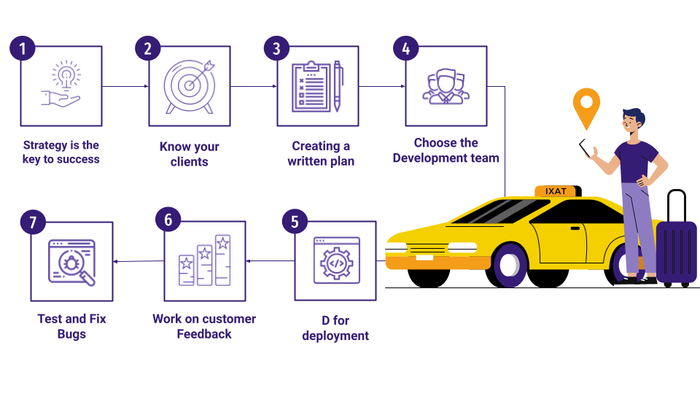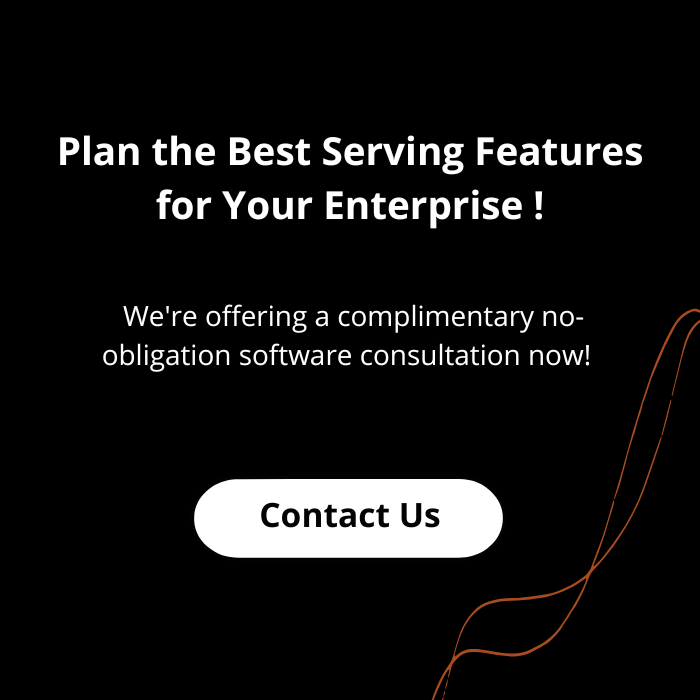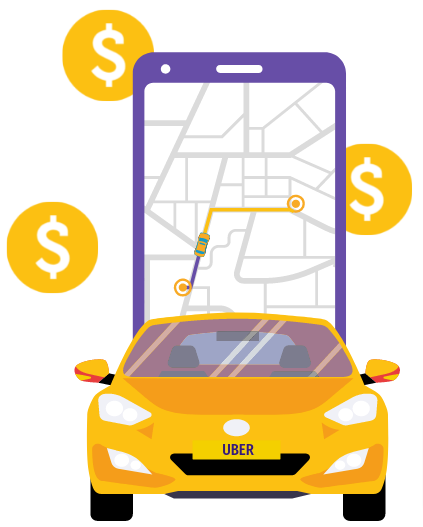Pandemic hasn’t limited my outdoor steps in the name of safety.
Going to a place regardless of the distance and hour of the day doesn’t bother me any longer.
Comfortable and convenient commute isn’t synonymous with owning a private vehicle these days.
..All these because of the uber like apps taking the intra & inter-city transportation scenario to a whole different level where booking a ride to almost all places across the city is just a click away.
According to Statista the number of monthly users being recorded 93 million only stands by that fact and indicates a brighter future, as with the traveling requirements slowly yet steadily getting back to normal and people avoiding public transport for obvious reasons.
So without further ado, let's steer into the nitty-gritties of Uber-like app development.
Get a Free Cab App Consultation !
Checking out the comprehensive guidelines for hiring app developers may ease the process for you.
How Do The Uber-Like Apps Really Work And What Can You Do To Stand Out?
Before moving on to the process of building an uber like app, having a quick look under the hood and finding out how they really work makes for a good prequel ! So the app mainly has two types of users – the driver and the rider. The rider’s objective is to reach the destination and the driver’s responsibility is to pick-up and drop. Let’s have a look at how the workflow of apps like Uber help both of its users's purposes sync through the process!
[1] Ride Request
Once the Uber like app is installed, the user has to request a ride from a specific location. Drivers in the vicinity can then access the request & each one of them can either accept or reject the request.
As the number of female drivers grows, your uber-like app can incorporate a module that allows your customers to choose between female and male drivers based on their preferences. Adding this feature will also help address the safety concerns of the female app users, ensuring extra safety.
[2] Finding A Match
According to Uber’s business logic, the one who accepts the ride request first, gets to execute the ride. But what happens when two drivers accept the ride at the same timestamp? The driver located closest to the pick-up point is assigned for the trip, prioritizing user’s convenience.
Coming to the innovation part here, that will give you that much sought after ‘competitive edge’ – include a questionnaire on the rider’s dashboard before mapping the user request to the nearby vehicles, where they can optionally add or specifically discard particular features of a vehicle for the most optimum ride to their destination. Sensitive to fragrances? Map the request to vehicles that don’t have a strong car freshener on. Choose to ride with extra luxe? Map such requests to the most comfortable luxury vehicles.
[3] Onboarding
Once vehicle is confirmed, the user is notified of the confirmation. At the same time :
Vehicle & driver details as well as an estimation in terms of ride fee and trip timing are made visible at the rider’s dashboard
And
The option to contact the rider is enabled on the driver’s dashboard
for a smoother start of the ride..
Incorporate quality machine learning in your app development to take up the challenge of hitting a precise estimation of trip fee (without having to deal with a loss or user’s grievances) and turn it to your USP. When used with a well developed foolproof route scheduling software, achieving that goal isn’t a very-hard-nut-to-crack.
[4] Payment Options
As mentioned already, prior to boarding, Uber-like apps will display a fare estimate. In terms of payment, the more options you give to your users the better. While going cashless is the new normal, e-wallet is a must-have option. However, uber like apps target users from a wide age range and so, cash or a credit or debit card shouldn’t be discarded too.That also helps when a passenger does not have access to the internet or money. Pro-tip : keep adding what’s hot & happening in the payment methods!.
[5] Feedback And Ratings
Upon completion of the ride, the riders as well as the driver get to rate each other and provide relevant comments to make the interaction easier for fellow riders and drivers.
Basic Features Of An Uber Like App
Features – that’s where many of the apps kill their potential right at the root! First of all – know who your uber like app is meant for and then layer your features around their needs and what can further add up to a ‘better’ riding experience. Presenting the ‘must have’ and ‘will be great to have’ features for your app to make it somewhat easier for you to sharpen up your competitive edge!
[1] Essential Features For Rider’s App
[a] Registration
Let the riders provide multiple sign in options – email address, a social media account are popular examples, but, you can innovate more. Think of incorporating an automated chatbot system in your uber like app to break the monotony in the usual registration process by answering FAQs and narrating simplified registration processes.
[b] Taxi Booking
This feature allows the riders to book a taxi by entering their address & specifying the pickup location and further by giving them the liberty to select a car.
Remember when we wanted to book a ride but couldn’t & instead “no cabs available” was displayed? Been there, seen that – you, me and all the consistent cab users too! So keep unavailability at bay and curb the waiting time for the users – try considering gamification in your uber like software to make the waiting period more exciting and engaging.
[c] Travel History
Travel history displays information from previous transactions and rides.
Many times, users are unable to retrieve information from their past rides
since they couldn’t find the specific trip. Add a search button to your uber-like app for your riders to easily find the exact ride they want..
[d] Push Notification & SMS
In addition to providing users with timely alerts and trip adjustments, push notifications help users stay informed about their taxi bookings.
To make sure your push-notifications hit the right balance between ‘coming off as important’ and ‘not being too pushy’ – ditch the old-school push notification features and try considering the cutting-edge ones :
[i] Rich Push :
Rich Push will change your app's alerts into something more aligned to social media posts, rather than merely text messaging or phone calls. You can use Rich Push to add movies, media assets, gifs, and other types of content.
[ii] Push Action Button
A push action button included in the push notification allows the message receiver to do things like snooze the message or share it on social media directly.
[iii] Push Stories
Push stories are stunning components that will allow you to add a picture gallery and activity button notices to your app.
[e] Price Calculator
To assist users with the rates, the exact estimated price is calculated even before booking the trip. You can innovate by adding a comparative tariff chart that will allow users to choose the most economical one among hundreds of similar taxi booking apps.
[f] Seamless Payment
Uber-like apps provide a gateway to pay through cards and wallets. But, how will one cope if they can't use the internet and don't have any cash on them? Investigate thoroughly and choose a technology that will ensure smooth cash flow even without the internet in order to avoid such problems. Perhaps enable payment during next trips for trusted longtime customers upto a certain monetary limit?
[2] Essential Features For Driver’s App
[a] Driver Rating And Reviews
Using this feature, drivers can find their ratings and reviews based on the route taken, comfort and their behaviour during the journey.
[b] Ratings For Users And Reviews
Here, just like users get to rate drivers, drivers can rate the riders too and write reviews about them.
[c] Driver Profile And Status
Drivers have to update detailed information through the ‘driver profile and status’ section from the driver’s app menu. Whether or not they have been verified, their car insurance, driving license, driving experience in years etc. are some of the fields they have to fill in. The driver profile also shows the driver's availability.
[d] Trip Alerts
Using trip alerts, drivers can accept or deny a request for a trip. Passenger location, route, and travel history are all included in trip alerts.
[e] Messaging
Both the driver and the passenger can communicate with each other via phone calls and SMS.You can add a module to your uber-like app that allows free calling and texting, which will save money for both riders and drivers.
[f] Driver-delivery Reports
Drivers can find out about their earnings by using driver delivery reports, which include daily or monthly trips and earnings statistics.
[3] Essential Features For Admin Panel
[a] CRM
When people interact with the company on social media sites like Facebook and Twitter, CRM gathers information about them. As a result, the CRM system keeps them as contacts. This enables Uber like apps to respond quickly to any complaints, ensuring that the company maintains a good public reputation.
[b] Vehicle Details Management
An owner of a self-owned vehicle is required to supply the firm with all vehicle information, such as vehicle identification numbers (VIN), car type, and insurance information. All of these facts are included in the vehicle management systems.
[c] Promotions And Discount Management
In addition to generating promo codes, the system also tracks which users are eligible for them. There's also a feature that checks the expiry date of promo codes and discounts.
[d] Booking Management System
The admin panel includes a booking management system that stores the rider's booking information which can be retrieved on demand.
[e] Payroll Management System
The payroll management system is an essential component of the admin panel that manages the financial records of the employees. This feature contains information about an employee's salary, incentives, hike details, and so on.
Advanced Features Of An Uber Like App
[1] Advanced Features For Driver’s App
[a] Navigation And Geo-Location
One of the striking features of Uber is that it knows which roads are the shortest and least trafficked. The geolocation functionality is the unsung hero making this possible. To execute a guided Uber ride, all your app needs are :
- A map
- A display showing all the adjacent turns
- Guidance on taking or avoiding those turns.
In today's world, we are all accustomed to the sight of a smartphone connected to the internet that provides directions to the driver. Suppose, however, that there was no internet connection and the motorist opted to drive on a busy road. What a nightmare, and you might have missed an important meeting or occasion. Unfair, for sure!
This is why real-time traffic tracking via FM radio is necessary to avoid a bad user experience. Traffic and travel information is sent to FM radio broadcasts through police stations, cameras, etc., to make the trip more convenient and efficient using TMC technology for navigation in cars.
Read more : 7 Hot Ideas for Location Based Apps
[b] Optimized Destination Points
For the navigation system to be able to retrieve travel and traffic information, the destination point is essential. Street numbers, zip codes, and POIs are some good examples, but you're free to come up with your own. While it may appear that adding a tonne of information will help the navigation system choose the best route, it’s not quite true. Adding more random details can only lead to further confusion. Do a lot of study to find out which technology is best suited to your modules.
Better road maps : Thanks to automatic OTA updates, you have the option of using both online and offline maps that provide correct information. So, say no to roadblocks from now on.
[c] Driver Alert
Consider including a driver alert system in your uber-style app like a fleet management software powered by artificial intelligence (AI) that anticipates driver behavior, prevents collisions, and saves you money.
A driver alert system should incorporate the following module:-
- Predictive collision alerts : To avert a collision, assess, predict, and inform drivers of impending dangers.
- Driver behavior alerts : Stop distracted and drowsy driving by providing real-time alerts to drivers.
- Incident Reporting : Reduce collision-related costs by providing timely and dependable incident video and data.
[2] Advanced Features For Rider’s App
[a] Prior Scheduling
Riders can pre-book a trip at a specific time using prior scheduling.
[b] Split Payment
Split payment allows a group of riders to share the cost of the ride making it more affordable.
[c] Waiting Time
There will be an additional charge for the user if the driver has to wait for more than 5 minutes.
Try including a module into your uber like app that alerts the rider when he or she is running late, saving the rider’s money.
[d] Panic Button
An Uber-like app with a panic button can help reduce safety issues. Users can contact customer service by pressing the panic button to alert them of any threats they are facing while riding.
[e] Book For Others
The "Book for others" option of an app like Uber allows its users to book a ride for any of their friends or family members.
To book a ride for someone else, the user only needs to provide the rider’s contact information. Next, the driver can contact the rider if they need more information about their location.
[f] Voice Search
Addition of voice search to your uber-like app will allow users to utilize their voice for a variety of different instructions.
As an example, you can now request an SUV by just saying "Book a SUV/ Book SUV."
What Makes Uber-Like Apps Effective?
For a long time, users had to wait in huge lines for taxis and hoped for a better alternative to this. Fortunately, their prayers have been answered.
Taxi booking has become easier and more convenient with the emergence of uber-like apps and as a result, apps like Uber have been incredibly successful.
There are three basic needs that customers have, that these apps addressed:
- Request from any location
- Riding in comfort
- Affordability
Their focus was not limited to just these three basic requirements, though.
[1] Surge Pricing
So, when demand is high, the costs of applications like Uber go up, which is hated by all. Unknown surge multiplier sits at the core of Uber's pricing. Neither its calculation nor its maximum limit are known. There have been complaints from those who ride with multipliers more than 5X about having to pay expensive fees. This is a simple problem to solve.
Users need a realistic ceiling, like 5X (beyond which there is evidence that users become dissatisfied), and explicit information that the spike price won't go higher. It would soothe customer concerns.
[2] Heat Maps
The driver app includes heat maps. A driver can see where there's a lot of demand on these maps. That region becomes red when there is a lot of demand in a certain location. Uber-like mobile apps can gather micro-mobility trends like bike and scooter travel patterns to provide insight into people's movements during COVID-19. As a result, users may now keep tabs on people's movements in specific areas.
[3] Safety & Security
In Uber-like apps, the taxi's location is updated in real time. It has a built-in phone and messaging system. The customer service team can answer any questions users may have over the phone. A crash-mitigation technology is available on newer Lytx models, providing drivers with real-time feedback through aural alerts.
- Audio recording : As the number of crimes increases every day. A button that records the conversation the user is having with the driver can be included in an Uber-like app. The driver will have the same privileges as well. In order to listen to the conversation, the parties will have to download it.
- Quick assistance : You can add a feature to your uber-like app that will quickly send help if the cab breaks down in the middle of the road.
How To Build Uber Like Apps – Step By Step Guide
Step 1 : Strategy Is The Key To Success
Planning is the most crucial part of any project. Plan poorly and you'll end up somewhere you never imagined.
Without a plan, the goal becomes hazy and unclear. The first step is to plan well. As an example, ask yourself, "What features do I need in my app? Which space should I invest my efforts in to get maximum ROI? What should be the look and feel of my app to be appealing to the users?” Getting the answers to your questions is a big step in the process. Identify your competitors, and analyse their baby steps carefully.
Step 2 : Know Your Clients
When you're ready, you'll need to decide who will be your target audience. Determine what they want next. Communicate! Talk to your customers to find out what they expect from you,so your task becomes much easier. As a result, you now know which functionalities you need.
Step 3 : Creating A Written Plan
This phase is focused on creating a solid foundation for your uber-like app. When’s the last time you saw someone develop an app without documenting the plan? Probably never. Prepare the essential paperworks with the help of a professional. Work on system designs, milestones, wireframes, and mockups.
Step 4 : Hire An Experienced Development Team
For your uber-like app to succeed, you need to find the ideal development team. Finding the correct one amid a crowd is a difficult task. Investigate their experience, portfolio, and reviews to have a deeper understanding.
Step 5 : Testing, Testing & Testing!
Once the app has been developed, the next step is to test it to see if all of its features work properly. An experienced team of testers is required to do this.
Step 6 : Working On Customer Feedback & Maintenance
Afterwards, take a break and create an online feedback portal. An user's feedback helps you learn how well your app is performing in the market and where it might improve. Keeping your app up-to-date is a must. A buggy app will not be popular with customers. Corrective measures should be taken to fix bugs. You should add new features to your app to keep current with the market, such as introducing a game. While riding, the public would become more involved.
Step 7 : D For Deployment
This is the phase where the product is made available to the public. Everything you've worked for is now paying off.
How To Monetize Uber-Like Apps
When you're constructing an Uber-like app, you'll need to know from where the money will be brought in. So, let’s check out how to monetize uber-style apps:-
[1] Revenue From Rides
Trip commissions bring in a lot of money. Uber, for example, charges a staggering 25% commission. When a ride is cancelled after a certain period of time, a cancellation fee is charged as well. There's also an extra charge for waiting time on apps like Uber.
[2] Dynamic Pricing Model
The cost of booking a ride isn't set in stone. Traffic, driver availability, demand, and supply all play a role. Whenever there is a high demand or a shortage of drivers, the price per kilometre automatically adjusts to reflect the price.
[3] More Services
Multiple services can be provided by an app similar to Uber. Your Uber-like app can offer a high-demand service by looking at it from the public's perspective. In order to provide luxury to your customers, you need to provide them with cost-effective solutions.
If you're looking for a no-contact delivery option, Uber offers Uber-connect and on the other hand Uber-freight, connects users with 65000 truck drivers. As a result, moving from one city to another is now a breeze when it comes to packing and moving. This way, you can earn extra cash.
[4] Paid Partnerships
Collaborations can bring in a lot of cash for the company. See what happens when you combine an uber-like app with a major brand. For example: When Uber partnered with Pepsi to promote their content, it benefitted Uber. Similarly, when Uber teamed up with Spotify, both companies saw an increase in their customer base.
How Much Does It Take To Build An Uber-Like App?
The cost to build an uber-like app depends on quite a few factors, including how many functions it has, where it's developed and how much it costs per hour, among others. The following are some of the most important factors that affect the price of taxi app development:
[1] Number Of Features And Functionalities
The cost of an Uber- like app will be influenced by the features, their functioning, and the complexity of building such features, among other factors. Users' authorisation, in-app purchases, gamification, geolocation, API connections will cost you considerably more. Consider the cost of your app as a function of how many functionalities you add.
It's possible to create an app on a shoestring budget by noting down the functionalities you can't compromise with and incorporating them into your app.
[2] Development Team
The cost to build your own Uber-like app is largely determined by the team that you will be working with. Charges increase as it gains more experience. The cost also varies greatly depending on where you hire them from. Consider their testimonials and portfolio, as well as get in touch with their prior clients for further information, before you hire them.
[3] Integrations
While it would take months to develop an uber-like software from scratch, third-party integrations allow you to add features and tools quickly. Incorporating third-party services can significantly increase the cost of developing an Uber-like app.
So, keep in mind your app's core goal. Consider which features are really vital to have in your app and then add them.
[4] Designing
An uber-like app's appearance and feel are two key factors in determining the app’s price. It will be cheaper to create a simple app than a complex one.
A couple of points to be noted: A responsive design means that your software should work on a wide range of devices. All you need is a simple, user-friendly, engaging design. Your app should be designed with your clients' needs in mind. Using the app should be easy for anyone who isn't as tech-savvy as you are.
[5] Interactive Elements
Adding multimedia elements to your app is a sure-fire way to get users' attention, but it comes at a price, and the more you want in your uber-like app, the more you'll have to pay.
[6] Maintenance Plan
The maintenance plan includes user reported bugs, app updates, and security updates.
Security should not be overlooked. You must be extra cautious about security in light of the increasing number of frauds. Uber-like apps must provide maximum security for the end-user while minimizing the hassle. As a result of these two factors coming together, prices will rise.
However, depending on the platform (iOS or Android), Uber like app development costs can range from $30,000 to $100,000. Costs can range from $300,000 to $500,000 or even more if you want a more complex and feature-rich product.
Let’s Plan Your Uber Like App !
Why Does Developing Your Uber Like App With BinaryFolks Make For A Wise Choice?
Driven by ex-engineers from Google, Amazon & Salesforce
101% Value For Money (+1 for Our Complimentary Consultation before You Spend Your 1st Dollar!)
Reviews That You Can Verify!
Safeguarded Business With An NDA
Out-Of-The-Box Innovations
Eye For Details
Questions Galore (Until Your Requirement & Our Understanding are mirror copies!)
Insight-Rich Scope Enhancement
Intense Domain Expertise
Close-knit feedback loop
Conclusion
Information? Checked.
Tips? Checked.
Challenges? Checked.
Don’t let the popularity of Uber, Ola, Lyft and similar industry giants fool you – those coexist in the market because of their individual speciality in the field because otherwise, it could have been a monopoly ! So the truth is it surely isn’t a cakedrive to steer in success with a new uber like app in the business but then, concrete research paired with a development team that has proven experience and expertise executing the researched plan is sure to accelerate your process of making a mark..


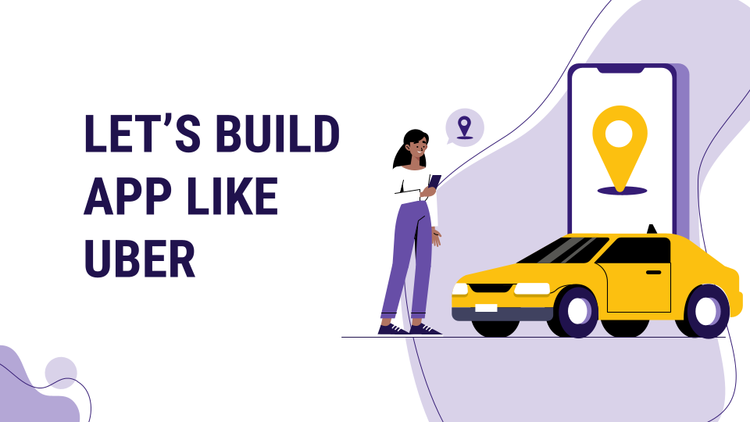
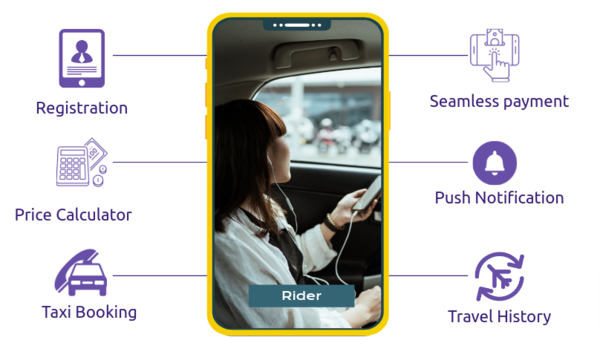
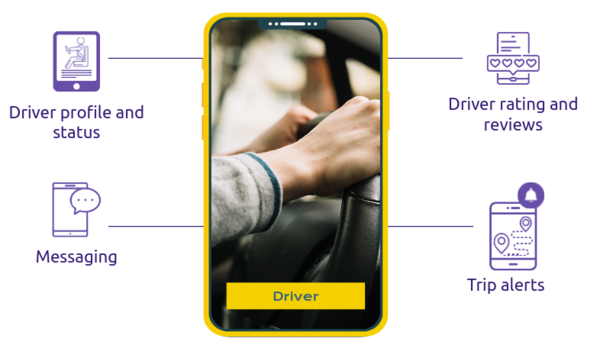
.png)
